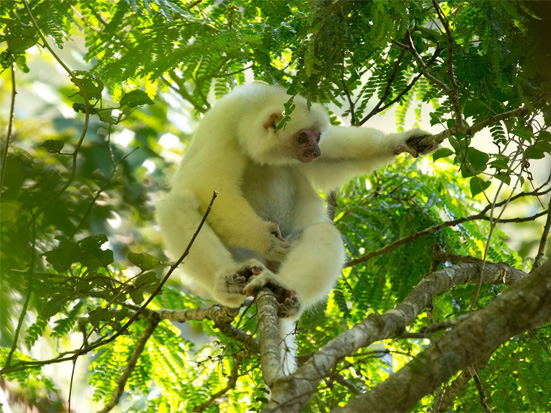Synthesis of the silky sifaka’s distribution (Propithecus candidus)
Keywords:
silky sifaka, Propithecus, candidus, vitiligoAbstract
In this paper I 1) review the population abundance and distribution of Propithecus candidus, 2) comment on Rabearivony et al. (2015) and Rasolofoson et al. (2007) regarding P. candidus elevational range, distribution, and lack of occurrence in the pet trade.
Résumé
Dans cette contribution je (1) reprends l’abondance et la distribution de la population de Propithecus candidus, et (2) commente les contributions de Rabearivony et al. (2015) et de Rasolofoson et al. (2007) à propos de l’aire de répartition et de la distribution altitudinale de P. candidus, ainsi que de son absence dans le commerce des animaux domestiques.
References
Banks, M. A., Ellis, E. R. and Wright, P. C. 2007. Global population size of a critically endangered lemur, Perrier's sifaka. Animal Conservation 10, 2: 254–262. (doi:10.1111/j.1469-1795.2007.00102.x)
Ganzhorn, J., Arrigo-Nelson, S., Carrai, V., Chalise, M., Donati, G., et al. 2016. The importance of protein in leaf selection of folivorous primates. American Journal of Primatology. (doi:10.1002/ajp.22550)
Golden, C. D. and Comaroff, J. 2015. The human health and conservation relevance of food taboos in northeastern Madagascar. Ecology and Society 20, 2: #42. (doi:10.5751/ES-07590-200242)
Goodman, S. M., Raherilalao. M. J., Rakotomalala, D., Raselimanana, A., Schutz, H. and Soarimalala, V. 2003. Les lémuriens. In: Nouveaux Résultats d’Inventaires Biologiques faisant Référence à l’Altitude dans la Région des Massifs Montagneux de Marojejy et d’Anjanaharibe-Sud. S. M. Goodman and L. Wilmé (eds.), pp 279–286. Recherches pour le Developpement, Série Sciences Biologiques, N. 19. Centre d'Information et de Documentation Scientifique et Technique, Antananarivo.
Irwin, M. T. 2008. Diademed sifaka (Propithecus diadema) ranging and habitat use in continuous and fragmented forest: Higher density but lower viability in fragments? Biotropica 40, 2: 231–240. (doi:10.1111/j.1744-7429.2007.00368.x)
IUCN 2015. The IUCN Red List of Threatened Species. Version 20 http://www.iucnredlist.org downloaded on 7 October 2015.
Jenkins, R. K. B, Keane, A., Rakotoarivelo, A. R., Rakotomboavonjy, V., Randrianandrianina, F. H., et al. 2011. Analysis of patterns of bushmeat consumption reveals extensive exploitation of protected species in eastern Madagascar. PLoS ONE 6, 12: e27570. (doi:10.1371/journal.pone.0027570)
Kun-Rodrigues, C., Salmona, J., Besolo, A., Rasolondraibe, E., Rabarivola, C., et al. 2014. New density estimates of a threatened sifaka species (Propithecus coquereli) in Ankarafantsika National Park. American Journal of Primatology 76: 515–528. (doi:10.1002/ajp.22243)
Loudon, J. E., Patel, E. R., Faulkner, C., Schopler, R., Kramer, R. A., et al. 2016. An ethnoprimatological assessment of human impact on the parasite ecology of silky sifaka (Propithecus candidus). In: Ethnoprimatology: A Practical Guide to Research on the Human-Nonhuman Primate Interface. A. Fuentes and E. Riley (eds.), Cambridge University Press. (In press)
Mittermeier, R. A., Louis Jr., E. E., Richardson, M., Schwitzer, C., Langrand, O., et al. 2010. Lemurs of Madagascar. 3rd edition. Conservation International Tropical Field Guide Series, Arlington, VA.
Norscia, I. and Palagi, E. 2008. Berenty 2006: census of Propithecus verreauxi and possible evidence of population stress. International Journal of Primatology 29, 4: 1099–1115. (doi:10.1007/s10764-008-9259-4)
Patel, E. R., Marshall, J. J. and Parathian, H. 2005. Silky sifaka (Propithecus candidus) conservation education in northeastern Madagascar. Laboratory Primate Newsletter 44, 3: 8–11.
Patel, E. R. 2007. Logging of rare rosewood and palisandre (Dalbergia spp.) within Marojejy National Park, Madagascar. Madagascar Conservation & Development 2, 1: 11–16. (doi:10.4314/mcd.v2i1.44124)
Patel, E. R. 2014. Silky sifaka Propithecus candidus Grandidier, 1871 Madagascar (2000, 2002, 2004, 2006, 2008, 2010, 2012). In: Primates in Peril: The World’s 25 Most Endangered Primates 2012-2014, C. Schwitzer, R. A. Mittermeier, A. B. Rylands, et al. (eds.), pp 38–43. Primate Specialist Group, International Primatological Society, Arlington and Conservation International IUCN/SSC.
Quéméré, E., Champeau, J., Besolo, A., Rasolondraibe, E., Rabarivola, C., et al. 2010. Spatial variation in density and total size estimates in fragmented primate populations: the golden-crowned sifaka (Propithecus tattersalli). American Journal of Primatology 72, 1: 72–80. (doi:10.1002/ajp.20754)
Rabearivony, J., Rasamoelina, M., Raveloson, J, Rakotomanana, H., Raselimanana, A. P., et al. 2015. Roles of a forest corridor between Marojejy, Anjanaharibe-Sud and Tsaratanana protected areas, northern Madagascar, in maintaining endemic and threatened Malagasy taxa. Madagascar Conservation & Development 10, 2: 85–92. (doi:10.4314/mcd.v10i2.7)
Rajaonarison, M. and Patel, E. R. 2013. Diet, ranging, and activity budget of wild silky sifakas in Makira. Prosimian Congress Abstract, Centre Valbio, Madagascar.
Rajaonarison, M. 2015. Etude de la Bioécologie et du Comportement de Propithecus candidus (Grandidier, 1871) de la Forêt d’Andaparaty, Parc Naturel de Makira, Nord-est de Madagascar. Unpubl. DEA Thesis. University of Antananarivo.
Rasolofoson, D., Rakotondratsimba, G., Rakotonirainy, O., Rakotozafy, L. M. A., Ratsimbazafy, J. H., et al. 2007. Influences des pressions anthropiques sur les lémuriens d’Anantaka, dans la partie est du plateau de Makira, Maroantsetra, Madagascar. Madagascar Conservation & Development 2, 1: 21–27. (doi:10.4314/mcd.v2i1.44126)
Reuter, K. E., Gilles, H., Wills, A. R., and Sewall, B. J. 2014. Live capture and ownership of lemurs in Madagascar: extent and conservation implications. Oryx 50, 2: 344–354. (doi:10.1017/S003060531400074X)
Salmona, J., Rasolondraibe, E., Jan, F., Besolo, A., Rakotoarisoa, H., et al. 2014. Conservation status and abundance of the crowned sifaka (Propithecus coronatus). Primate Conservation 28: 73–83.
Sato, H., Santini, L., Patel, E. R., Campera, M., Yamashita, N., et al. 2016. Dietary flexibility and feeding strategies of Eulemur: a comparison with Propithecus. International Journal of Primatology 37, 1: 109–129. (doi:10.1007/s10764-015-9877-6)
Sterling, E. J. and McFadden, K. 2000. Rapid census of lemur populations in the Parc National de Marojejy, Madagascar. In: A Floral and Faunal Inventory of the Parc National de Marojejy, Madagascar: with Reference to Elevational Variation. S. M. Goodman (ed.), pp 265–274. Fieldiana Zoology, new series 97.
Wright, P. C., Erhart, E. M., Tecot, S. R., Baden, A. L., Arrigo-Nelson, S., et al. 2012. Long-term lemur research at Centre ValBio, Ranomafana National Park, Madagascar. In: Long-Term Field Studies of Primates. P. M. Kappeler and D. P. Watts (eds.), pp 67–100. Springer-Verlag Berlin Heidelberg, Berlin. (doi:10.1007/978-3-642-22514-7_4)

Downloads
Additional Files
Published
Issue
Section
License
All journal content, except where otherwise noted, is licensed under a creative common Attribution 4.0 International and is published here by the Indian Ocean e-Ink under license from the author(s).


